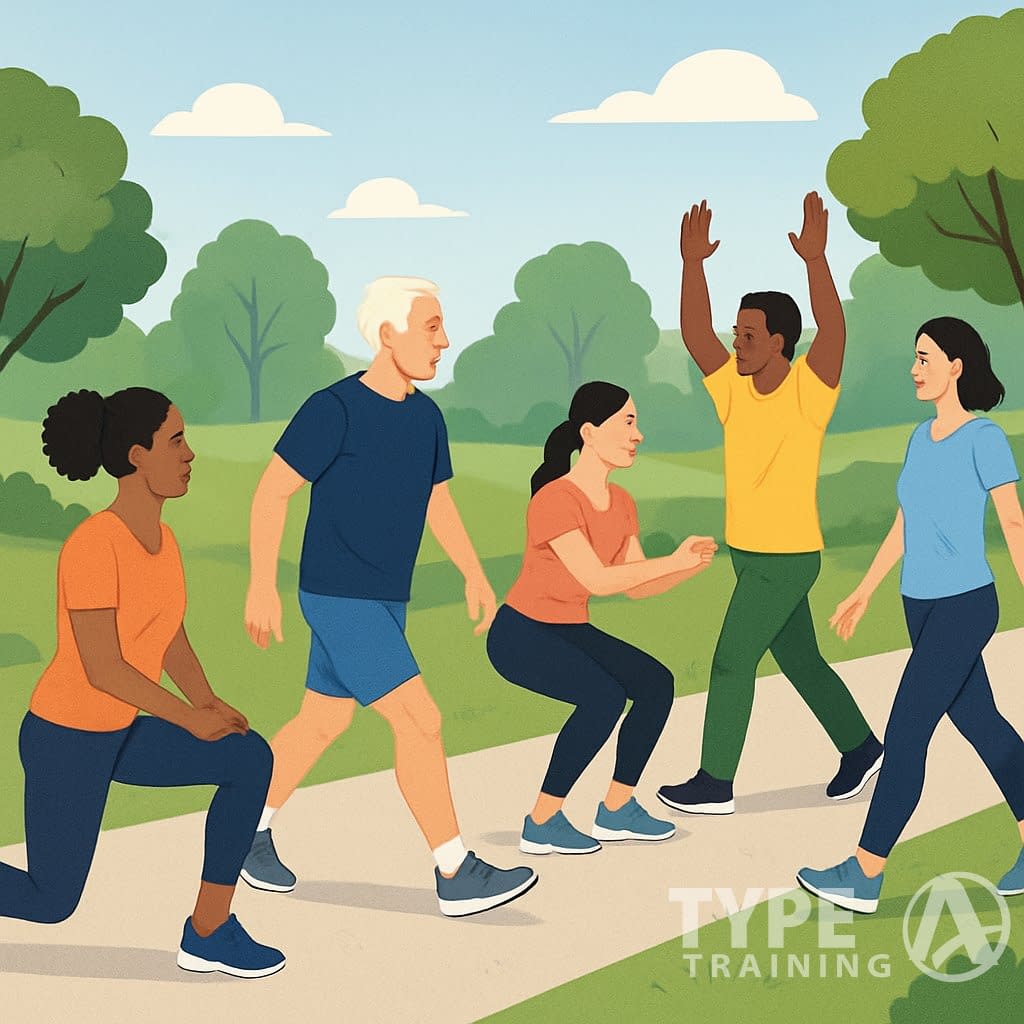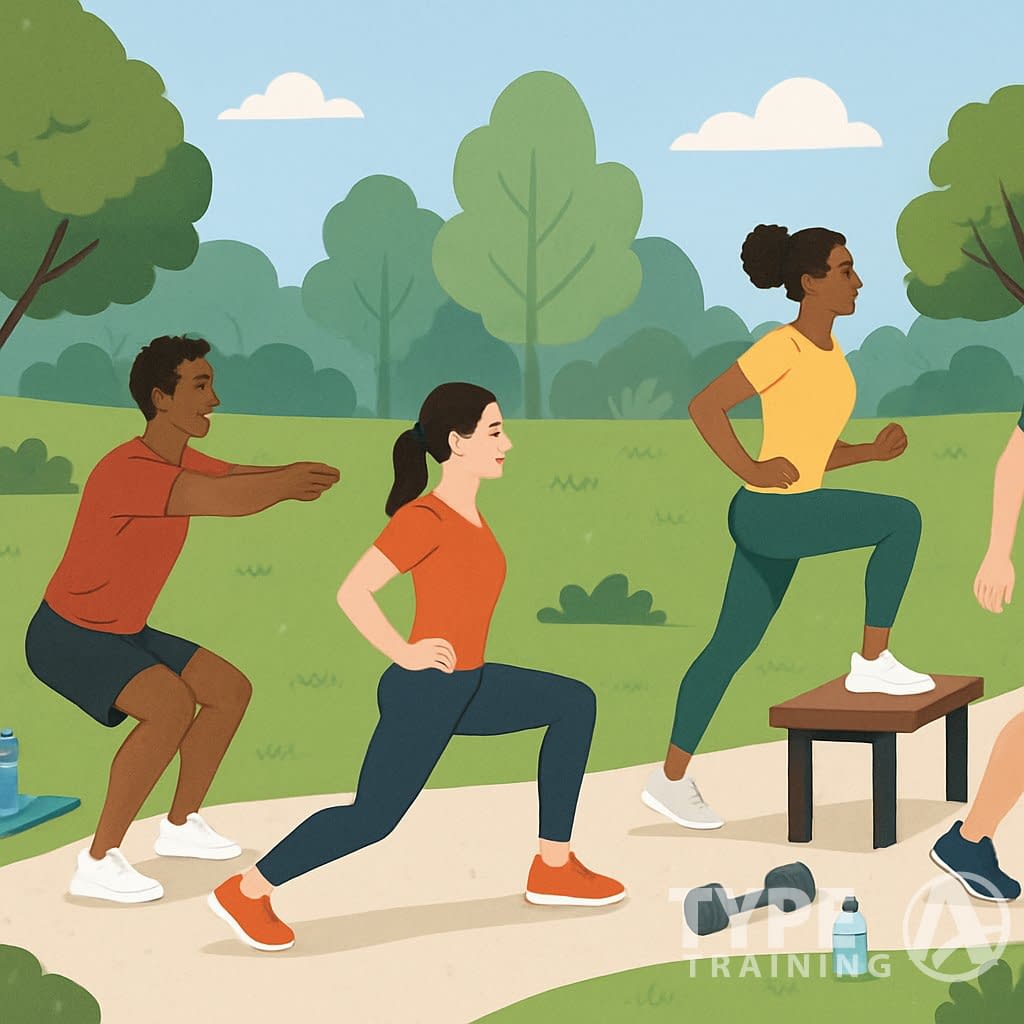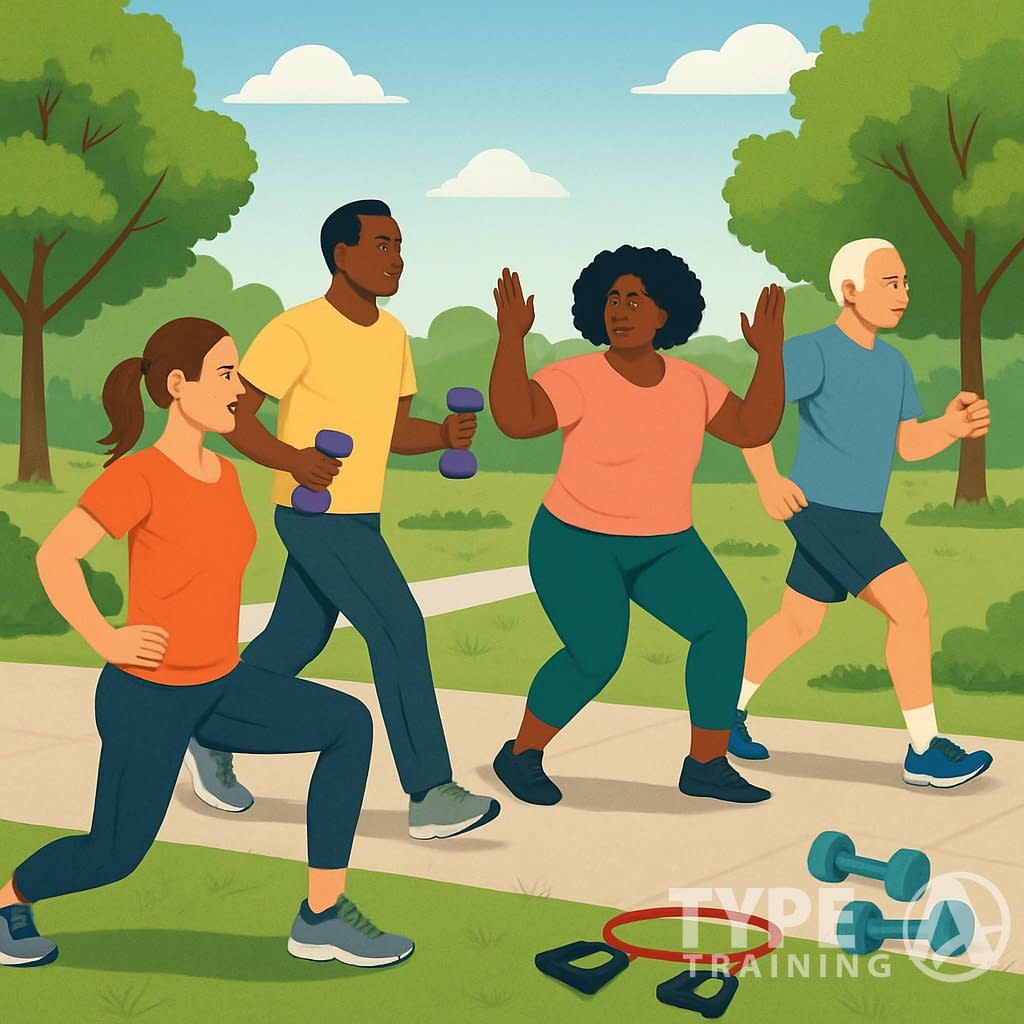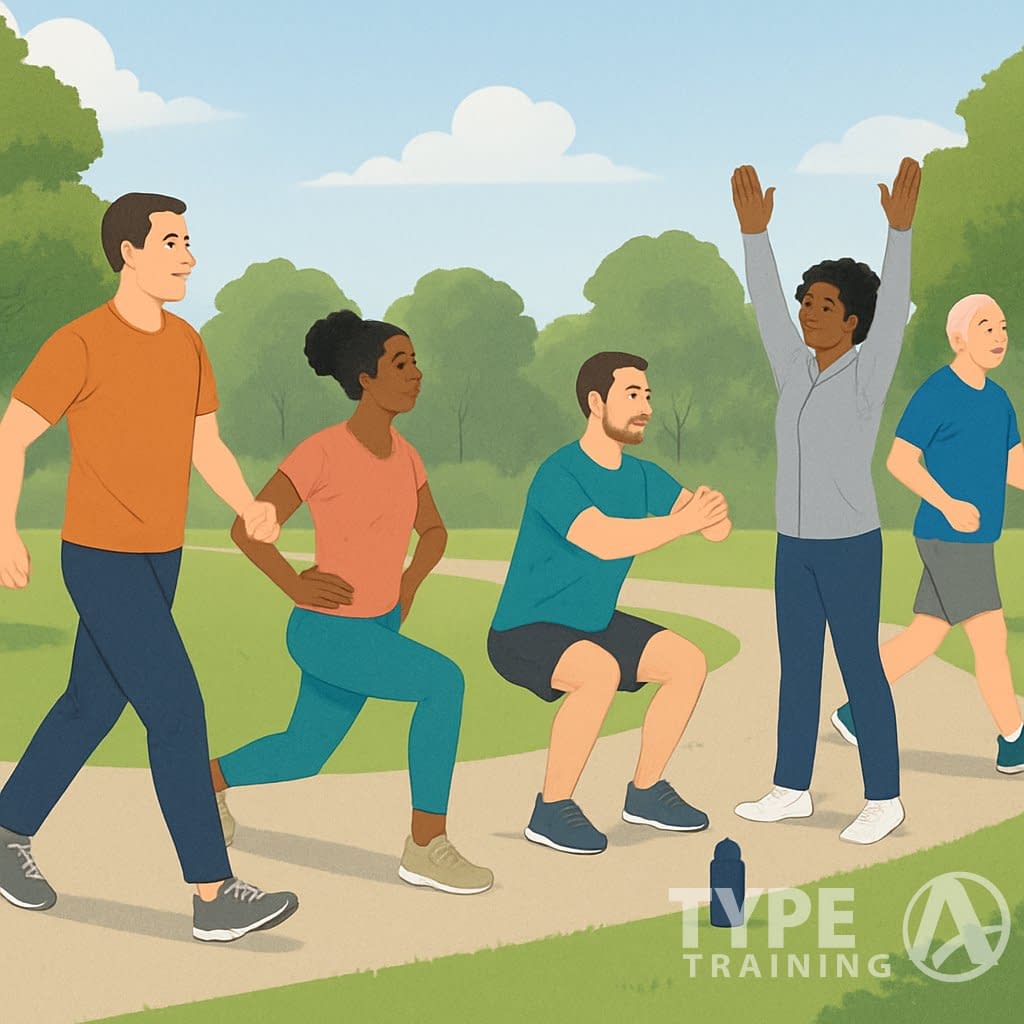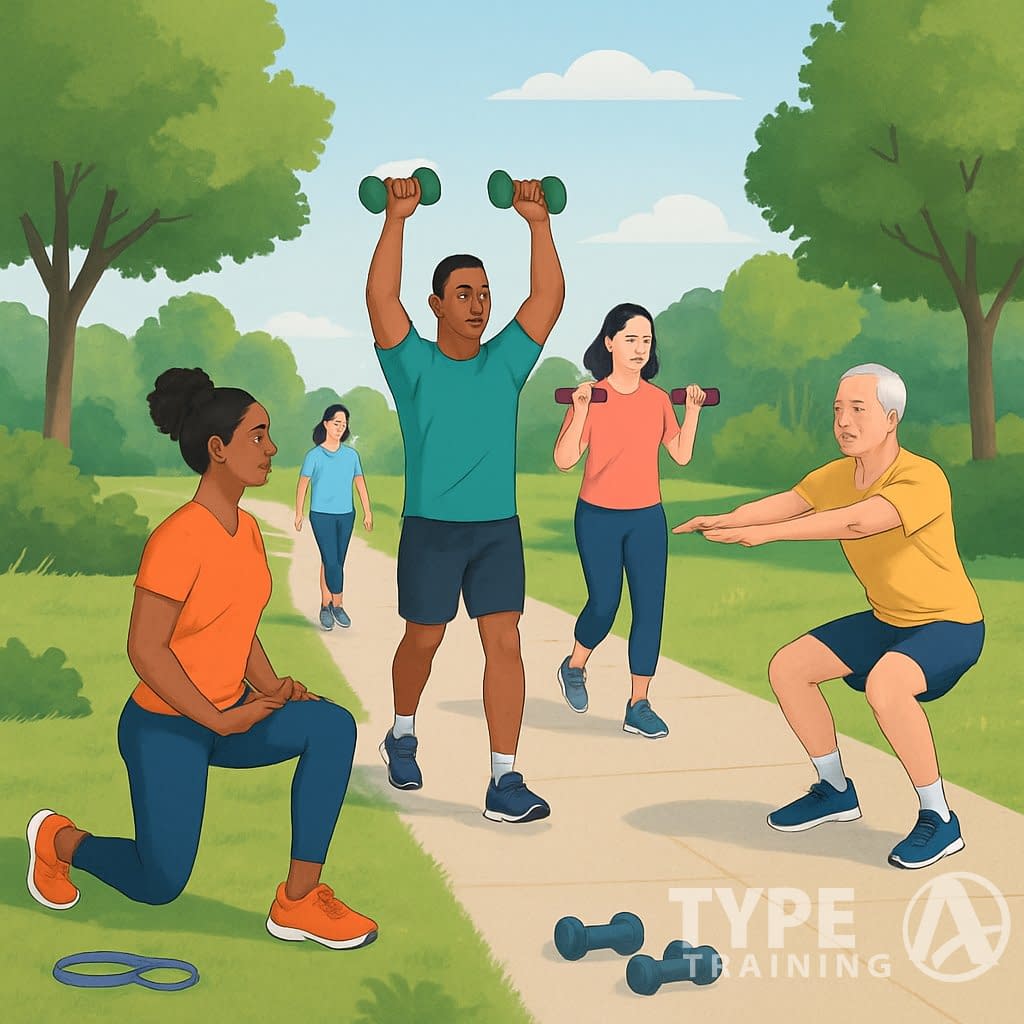Are you tired of your same old walking routine? Adding strength moves to your walks can totally change a simple stroll into a full-body workout.
The walking strength circuit blends cardio and resistance training in one session. You’ll build muscle and still get your steps in—no need to pick one or the other.

By adding just a few simple exercises to your walks, you can build more muscle and boost your fitness without spending extra time working out. This method gives you the heart-healthy perks of walking while also strengthening your upper body, lower body, and core.
Popular posts:
You’ll burn more calories and improve your overall fitness in less time. And you don’t need fancy equipment or a pricey gym membership to get started.
Simple bodyweight exercises like squats, lunges, and push-ups against a bench fit right into your walking routine. Parks, neighborhoods, even your lunch break at work—they all work.
Key Takeaways
- Walking strength circuits combine cardio and resistance training to improve overall fitness in less time than separate workouts.
- You can turn your regular walks into effective full-body workouts using just your bodyweight and whatever you find outdoors.
- Alternating between walking intervals and strength exercises creates a circuit training effect that builds muscle and boosts metabolism.
What Is the Walking Strength Circuit?
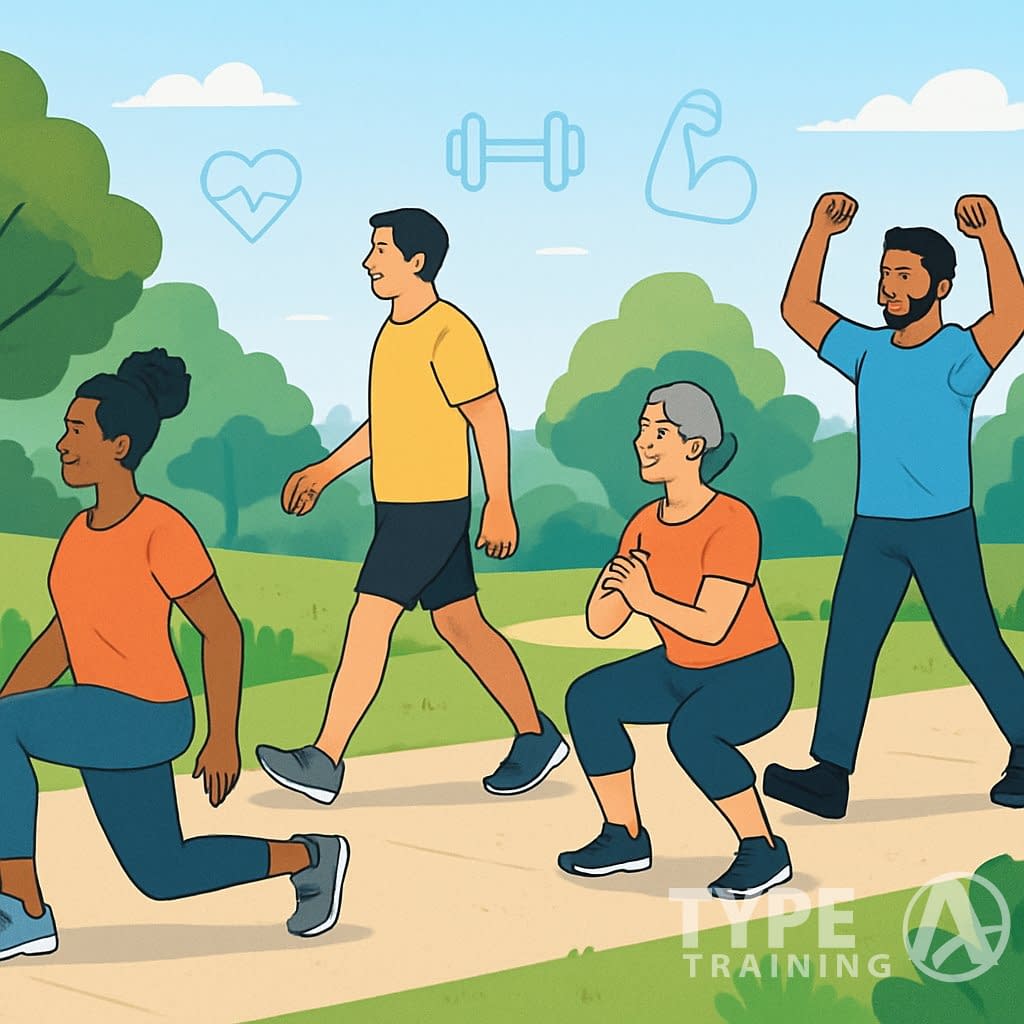
The walking strength circuit mixes regular walking with targeted strength exercises to create a full workout. You’ll improve both your cardiovascular fitness and muscle strength at the same time.
This approach makes the most of your exercise time. No gym membership or special equipment needed.
Combining Walking and Strength Training
Walking strength circuits blend two great types of exercise into one. Start with a brisk walk for 5-10 minutes to warm up.
Pause for a bit to do specific strength exercises, then return to walking. This back-and-forth helps you build endurance and muscle at the same time.
The walking parts get your heart rate up. The strength moves build muscle and kickstart your metabolism.
You can adjust your circuit to match your fitness level. Beginners might walk for 10 minutes, then do 1-2 strength moves. If you’re more advanced, try walking for 5 minutes before a set of 3-5 strength exercises.
Core Principles of the Circuit
A walking strength circuit sticks to a few key ideas. First, there’s interval-based training—switching between walking and strength work for those exercise “pulses.”
Next, focus on compound movements that hit multiple muscle groups at once. Squats, lunges, push-ups… you get more done in less time.
Consistency is the third principle. Try this pattern:
- 5-10 minutes of walking
- 30-60 seconds of strength exercise
- Back to walking
- Repeat with new exercises
You don’t need fancy gear—your own body weight, a bench, or a curb are enough. That’s why the walking strength circuit works so well outdoors or while traveling.
Essential Benefits of Adding Strength Exercises to Walking
Mixing strength exercises into your walking routine creates a surprisingly powerful combo. You’ll boost your cardiovascular system, build muscle, and burn more calories—all with a few tweaks to your walk.
Boosting Cardiovascular Health
Walking already helps your heart, but adding strength moves takes it up a notch. Alternating between walking and strength exercises creates a mini circuit that challenges your heart in new ways.
This change in intensity—from steady walking to strength moves—teaches your heart to handle different demands. Over time, your cardiovascular system gets better at delivering oxygen everywhere it needs to go.
You might even notice your resting heart rate dropping, which is a good sign. The American Heart Association actually recommends mixing cardio and strength for healthy
Better blood circulation means your muscles and organs get more nutrients. That helps you recover faster and just feel better overall.
Enhancing Muscle Strength and Endurance
Walking mostly works your lower body. But toss in some strength exercises and you get a more complete workout.
Your legs get the double benefit of walking’s endurance and the challenge of squats or lunges. This combo helps you keep your balance and stability, especially as you get older.
Adding upper body exercises during walking breaks gives you functional strength for daily life. It also helps prevent muscle imbalances that could mess with your posture.
Muscular endurance improves a lot when you mix walking with strength work. Your muscles learn to last longer without burning out.
All the different movements keep your joints flexible and your range of motion wide. That means better mobility and less stiffness day to day.
Increasing Calorie Burn and Supporting Weight Loss
A walking-strength circuit torches more calories than walking by itself. Strength moves ramp up your metabolism during and after your workout.
That’s the “afterburn effect,” or EPOC (Excess Post-exercise Oxygen Consumption). Your body keeps burning extra calories for hours after you’re done.
Circuit training that mixes walking with strength can burn up to 30% more calories than just steady walking. So your workout time works harder for you.
Building muscle with strength training also bumps up your basal metabolic rate. Even when you’re chilling on the couch, muscle tissue burns more calories than fat.
Mixing things up keeps your body guessing and helps you avoid those annoying fitness plateaus. You’ll keep burning calories efficiently.
Key Strength Moves to Include in Your Routine
Adding targeted strength exercises to your walk makes your routine way more effective. You’ll build endurance, stability, and power, all while focusing on the muscles you use when you walk.
Bodyweight Exercises: Squats, Lunges, Push-Ups
Bodyweight exercises are easy to add anywhere—no equipment, no excuses. Squats hit your glutes, quads, and hamstrings, which are your main walking muscles.
Stand with feet shoulder-width apart, lower down like you’re sitting in a chair, then push through your heels to rise. Lunges target similar muscles and also train your balance.
Step forward with one leg, bend both knees to 90 degrees, and push back. Walking lunges spice things up.
For upper body strength, squeeze in some push-ups. If regular push-ups feel tough, try them against a wall or on your knees.
Aim for 2-3 sets of 8-12 reps each. Here’s a quick circuit you can sneak in between walking intervals:
- 15 squats
- 10 lunges (each leg)
- 8-10 push-ups
Effective Dumbbell Exercises
Light dumbbells can really level up your routine. A balanced strength program works both upper and lower body, and dumbbells help you hit more muscles at once.
Start with 3-5 pound weights and try these:
Goblet Squats: Hold a dumbbell at your chest. Squat down, keeping the weight close.
Walking Lunges with Bicep Curls: Step into a lunge while curling dumbbells up.
Bent-Over Rows: Feet hip-width, hinge at the hips, pull weights toward your ribs.
Go for 2 sets of 10-12 reps each. Add these after your walk when your muscles are warm, or sprinkle them in as active breaks during longer walks.
Balance and Standing Crunch Variations
Balance exercises train your stabilizers and coordination—super important for walkers. Standing moves can even help you get into a meditative state while building functional strength.
Try these:
Standing Side Bends: Hold a dumbbell in one hand, feet hip-width. Bend sideways toward the weight, then back to center. Do 10 reps, then switch.
Standing Knee-to-Elbow: Bring opposite knee and elbow together. Works your obliques and coordination.
Single-Leg Balance: Stand on one foot for 30 seconds, then switch. Make it harder by moving your arms or closing your eyes.
High knees crank up your core and your heart rate. Lift each knee toward your chest 25 times per leg for a quick core boost.
Calf Raises and Glute Activation
Strong calves and glutes give you power and stability. These are simple but super effective.
Calf Raises: Stand with feet hip-width, rise onto your toes, pause, then lower. Make it harder with single-leg raises or dumbbells.
Glute Bridges: Lie on your back, knees bent, feet flat. Lift hips up, squeeze glutes, hold, then lower.
Donkey Kicks: Start on hands and knees, lift one leg behind you, knee bent, foot up. Focus on squeezing your glute.
Do 15-20 reps of each, 2-3 sets. Try these at the start of your walk as a warm-up, or at the end to really tire out those muscles.
How to Structure a Walking Strength Circuit
Building a walking strength circuit is all about mixing simple exercises with walking intervals. It’s a straightforward way to get stronger and support your heart—no gym, no complicated gear required.
Sample 20-Minute Walking Workout
Start with a 3-minute moderate-paced walk to get your muscles ready. Then alternate between these intervals:
- 2 minutes of brisk walking
- 1 minute of bodyweight squats (10-15 reps)
- 2 minutes of brisk walking
- 1 minute of push-ups (modified if you need, 8-12 reps)
- 2 minutes of brisk walking
- 1 minute of walking lunges (10 each leg)
Go through this sequence twice. Finish up with a 2-minute cool-down walk at a relaxed pace.
You can do this simple bodyweight circuit workout in almost any neighborhood or park. It’s convenient and doesn’t require much planning.
Keep an eye on your heart rate to make sure you’re working at about 60-75% of your max during the walking parts.
Sequencing Strength and Cardio Intervals
Proper sequencing makes a walking strength circuit work. Pick 3-5 strength exercises that hit different muscle groups.
Alternate between 1-2 minutes of walking and 30-60 seconds of strength moves. This keeps your heart rate up but lets muscles recover a bit.
For a solid routine, check out a strength-training plan that puts exercises in a smart order:
- Start with big muscle groups (squats, lunges)
- Move to upper body (push-ups, rows)
- Wrap up with core (planks, mountain climbers)
This sequence helps you burn more calories and keeps any single muscle group from getting overworked.
Adjusting Workouts for Different Fitness Levels
Beginner Level: Keep intervals short—1 minute walking, 30 seconds strength. Use easier versions like wall push-ups instead of regular ones.
Intermediate Level: Bump it up to 2 minutes brisk walking and 45 seconds strength. Add small hand weights (1-3 lbs) for more challenge on squats and lunges.
Advanced Level: Try 3 minutes of fast walking or light jogging, then 60 seconds of tough strength moves. Mix in things like jump squats or decline push-ups.
As you get stronger, tweak your walking workout plan. If a workout feels easy two times in a row, it’s probably time to step it up.
Tips for Getting the Most Out of Your Workout
Getting the most from your walking strength circuit takes a bit of prep and some flexibility in your approach. Good body alignment matters too.
Proper Warm-Up and Stretching Techniques
Before your walking workout, spend 5-10 minutes warming up. Start with a slow walk to gently raise your heart rate.
Dynamic stretches are best before you really get moving. Try high knees, mountain climbers, and butt kicks—about 25 reps each.
For your upper body, do 26 arm circles in each direction. It helps loosen up your shoulders and gets blood flowing.
After your workout, use static stretches. Hold each for 20-30 seconds, especially for calves, hamstrings, quads, and shoulders.
Stretching really does lower your injury risk and helps you move better over time.
Maintaining Good Form and Posture
Your posture during walking makes a big difference. Keep your head up and look ahead, not at the ground.
Roll your shoulders back and down. This opens your chest and makes breathing easier.
Engage your core muscles as you walk. It supports your spine and keeps you stable.
Take steps that feel natural—don’t force them too short or too long. Land on your heel first, then roll forward and push off your toes.
Arm Movement Tips:
- Bend elbows around 90 degrees
- Swing arms from the shoulders, not just the elbows
- Keep the motion controlled and purposeful
Bad posture can lead to back pain and make your workout less effective. Check in with your form now and then.
Incorporating No Equipment Options
You don’t need fancy gear to ramp up your walking workouts. Use your own body weight for extra resistance.
Try these:
- Walking lunges (10-12 per leg)
- Bodyweight squats at stoplights
- Calf raises while you’re waiting to cross
- Push-ups against a bench or wall
Varied terrain adds intensity. Hunt down hills for natural resistance, or take the stairs when you can.
Interval training doesn’t need equipment but really boosts the challenge. Walk at your normal pace for 2 minutes, then pick it up for 30 seconds. Keep alternating.
Landmarks make great interval markers. Walk fast between lamp posts, then slow down until the next one.
Safety Considerations and Progression
Mixing strength moves into your walk means you need to think about safety and how to progress. Listen to your body and make changes slowly to avoid injuries.
Monitoring Blood Pressure and Health Markers
Talk to your doctor before starting a walking strength circuit, especially if you have high blood pressure or heart concerns. Check your
If you notice chest pain, serious shortness of breath, or dizziness, stop right away and get help.
Keep a simple health journal to note:
- Resting heart rate
- Blood pressure
- Energy levels
- How long it takes you to recover
A personal trainer can help you get started safely and tailor workouts to your needs.
Progressing Your Circuit Safely
Begin with the easiest version of each move. Focus on getting the form right instead of chasing reps or weight. Good form is essential for learning new exercises.
Increase your routine slowly:
- Start with 1-2 exercises per walk
- Add one new move every week or two
- Bump up reps before adding weights
- Stay consistent rather than going all-out
Balance work matters too. Use a chair or wall for support at first. Heel-to-toe walking can really help your stability.
Rest days are important. Leave about 48 hours between strength sessions for the same muscle group to recover.
Incorporating the Walking Strength Circuit Into Your Routine
You don’t have to overthink adding strength work to your walks. With a little planning, you can build a fitness habit that actually sticks.
Building Consistency and Motivation
Pick specific days for your walking strength circuit. Aim for 2-3 sessions a week, leaving rest days in between for your muscles to recover.
A lot of folks find that alternating between walking and strength moves keeps things interesting and works the whole body.
Set goals that make sense for where you’re at now. If you’re just starting strength training, begin with 1-2 exercises during your walk and add more as you go.
Sample Weekly Schedule:
- Monday: 30-minute walk with 3 strength stops
- Wednesday: 20-minute walk with 5 strength stops
- Friday: 40-minute walk with 2-3 strength stops
Having a walking buddy can make you more likely to stick with it. Plus, it makes the strength stops a little more fun—and maybe even a tiny bit competitive.
Tracking Your Progress and Results
Grab a fitness app or just a regular notebook to log your walking strength workouts. Jot down a few things each time:
- Total walking time or distance
- Number of strength exercise sets you finished
- Weight you used, if any
- How you actually felt during and after the workout
Once a month, snap a photo or take some measurements. It might sound silly, but it helps you spot physical changes over time.
A lot of people start to see better posture and muscle tone after about 4 to 6 weeks of sticking with it.
Don’t just focus on numbers. Notice if walking uphill doesn’t leave you breathless anymore, or if carrying groceries feels less like a workout. Those everyday wins? They might matter more than any stat.
Every few weeks, shake things up to prevent plateaus. Maybe tack on more reps, bump up the weights, or try out new strength moves that go well with walking.
Keeping your routine interesting is half the battle.


